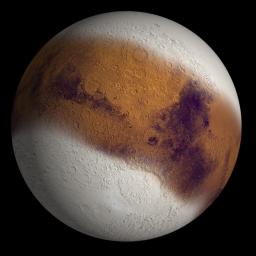
|
Mars Ice Age, Simulated
- Click the image above for a larger view
- Full-Res JPEG (2880 x 2880) (717.5 kB)
- Full-Res TIFF (2880 x 2880) (15.4 MB)
Caption:
December 17, 2003
This simulated view shows Mars as it might have appeared during the height of a possible ice age in geologically recent time.
Of all Solar System planets, Mars has the climate most like that of Earth. Both are sensitive to small changes in orbit and tilt. During a period about 2.1 million to 400,000 years ago, increased tilt of Mars' rotational axis caused increased solar heating at the poles. A new study using observations from NASA's Mars Global Surveyor and Mars Odyssey orbiters concludes that this polar warming caused mobilization of water vapor and dust into the atmosphere, and buildup of a surface deposit of ice and dust down to about 30 degrees latitude in both hemispheres. That is the equivalent of the southern Unites States or Saudi Arabia on Earth. Mars has been in an interglacial period characterized by less axial tilt for about the last 300,000 years. The ice-rich surface deposit has been degrading in the latitude zone of 30 degrees to 60 degrees as water-ice returns to the poles.
In this illustration prepared for the December 18, 2003, cover of the journal Nature, the simulated surface deposit is superposed on a topography map based on altitude measurements by Global Surveyor and images from NASA's Viking orbiters of the 1970s.
Background Info:
Mars Global Surveyor and Mars Odyssey are managed by NASA's Jet Propulsion Laboratory, a division of the California Institute of Technology, Pasadena, for the NASA Office of Space Science, Washington.
Cataloging Keywords:
| Name | Value | Additional Values |
|---|---|---|
| Target | Mars | |
| System | ||
| Target Type | Planet | |
| Mission | 2001 Mars Odyssey | Mars Global Surveyor (MGS), Viking |
| Instrument Host | Mars Odyssey | Mars Global Surveyor, Viking 1 Orbiter, Viking 2 Orbiter |
| Host Type | Orbiter | |
| Instrument | Mars Orbiter Camera (MOC) | Thermal Emission Imaging System (THEMIS), Visual Imaging Subsystem |
| Detector | ||
| Extra Keywords | Atmosphere, Color, Dust, Map, Rotation, Water | |
| Acquisition Date | ||
| Release Date | 2003-12-18 | |
| Date in Caption | 2003-12-17 | 2003-12-18 |
| Image Credit | NASA/JPL/Brown University | |
| Source | photojournal.jpl.nasa.gov/catalog/PIA04933 | |
| Identifier | PIA04933 | |
